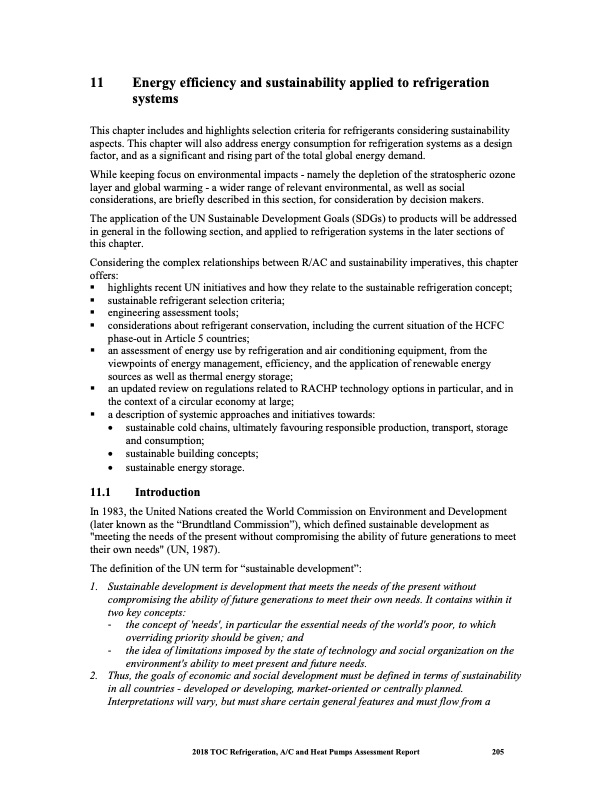
PDF Publication Title:
Text from PDF Page: 218
11 Energy efficiency and sustainability applied to refrigeration systems This chapter includes and highlights selection criteria for refrigerants considering sustainability aspects. This chapter will also address energy consumption for refrigeration systems as a design factor, and as a significant and rising part of the total global energy demand. While keeping focus on environmental impacts - namely the depletion of the stratospheric ozone layer and global warming - a wider range of relevant environmental, as well as social considerations, are briefly described in this section, for consideration by decision makers. The application of the UN Sustainable Development Goals (SDGs) to products will be addressed in general in the following section, and applied to refrigeration systems in the later sections of this chapter. Considering the complex relationships between R/AC and sustainability imperatives, this chapter offers: highlights recent UN initiatives and how they relate to the sustainable refrigeration concept; sustainable refrigerant selection criteria; engineering assessment tools; considerations about refrigerant conservation, including the current situation of the HCFC phase-out in Article 5 countries; an assessment of energy use by refrigeration and air conditioning equipment, from the viewpoints of energy management, efficiency, and the application of renewable energy sources as well as thermal energy storage; an updated review on regulations related to RACHP technology options in particular, and in the context of a circular economy at large; a description of systemic approaches and initiatives towards: • sustainable cold chains, ultimately favouring responsible production, transport, storage and consumption; • sustainable building concepts; • sustainable energy storage. 11.1 Introduction In 1983, the United Nations created the World Commission on Environment and Development (later known as the “Brundtland Commission”), which defined sustainable development as "meeting the needs of the present without compromising the ability of future generations to meet their own needs" (UN, 1987). The definition of the UN term for “sustainable development”: 1. Sustainable development is development that meets the needs of the present without compromising the ability of future generations to meet their own needs. It contains within it two key concepts: - the concept of 'needs', in particular the essential needs of the world's poor, to which overriding priority should be given; and - the idea of limitations imposed by the state of technology and social organization on the environment's ability to meet present and future needs. 2. Thus, the goals of economic and social development must be defined in terms of sustainability in all countries - developed or developing, market-oriented or centrally planned. Interpretations will vary, but must share certain general features and must flow from a 2018 TOC Refrigeration, A/C and Heat Pumps Assessment Report 205PDF Image | Heat Pumps Technical Options

PDF Search Title:
Heat Pumps Technical OptionsOriginal File Name Searched:
RTOC-assessment-report-2018_0.pdfDIY PDF Search: Google It | Yahoo | Bing
CO2 Organic Rankine Cycle Experimenter Platform The supercritical CO2 phase change system is both a heat pump and organic rankine cycle which can be used for those purposes and as a supercritical extractor for advanced subcritical and supercritical extraction technology. Uses include producing nanoparticles, precious metal CO2 extraction, lithium battery recycling, and other applications... More Info
Heat Pumps CO2 ORC Heat Pump System Platform More Info
| CONTACT TEL: 608-238-6001 Email: greg@infinityturbine.com | RSS | AMP |